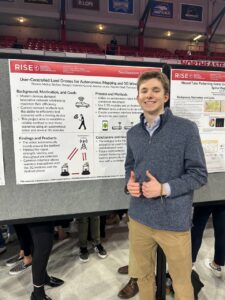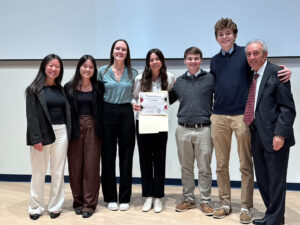Bridging Together Computer Engineering and Computer Science for Powerful Research

Thomas Michel, E’25, computer engineering and computer science, gained a vast number of technical skills and deepened his understanding of two industries in his double degree program. Throughout his journey at Northeastern, he has worked on advanced research projects, engaged in vigorous coursework and gained real-world work experience through two incredible co-ops.
Thomas Michel’s decision to pursue computer engineering and computer science was deeply influenced by his family’s example. With a mother working in computer science, a father in computer engineering and a sister who graduated from Northeastern’s College of Engineering, the program offered not only the ideal academic path but also a continuation of a family legacy in the field.
Michel first became interested in computer science because of the unique and advanced courses his high school offered. Looking to deepen his understanding of engineering and gain experience working with hardware, Michel was excited to start the computer engineering program, while combining it with computer science, at Northeastern University. He believes computer science has helped him excel in computer engineering by teaching him how to properly write and create code. The computer engineering program has advanced his skills and prepared him for a future career in the engineering field.
Co-op at the Institute for Wireless Internet of Things
Michel’s first co-op experience was with the Institute for Wireless Internet of Things, working under Professor Stefano Basagni as a software developer. The institute uses a wireless network emulator named “Colosseum,” housed at Northeastern’s Innovation Campus in Burlington, Massachusetts, to emulate myriad wireless scenarios. Michel was challenged to develop a creative solution to a pressing issue in the lab: the need for a centralized system to collect server logs, extract key metrics and present them through clear visualizations. While previous software addressed part of this need, it was incompatible with the lab’s other existing tools, creating significant obstacles. In his role, Michel implemented an open-source database as an alternative to the software they were using with Colosseum. In addition to working with new software, Michel said this co-op experience was his introduction into the world of research, and it inspired him to pursue research and academia more after graduation.

Michel presenting his research with the PEAK program.
After his co-op experience was completed, Michel decided to stay at the Wireless Internet of Things through the PEAK program at Northeastern. PEAK stands for “Project-Based Exploration for the Advancement of Knowledge” and is an incredible fellowship program that is designed to support students during their research endeavors. During his time in PEAK, Michel worked with a tool called “Arena,” which can communicate with different antennas within the lab. The lab has a robot called TurtleBot 4, and they wanted the robot to move autonomously around the lab while communicating with these antennas at different locations, as well as collect metrics. Michel developed a Python library that wirelessly connected with two 5G modems to communicate with the antennas in the lab and have them collect metrics. Michel values the opportunity he had to remain in the lab and contribute to unique projects that demanded innovative problem-solving.
Co-op at Pendar Technologies
Michel completed his second co-op at Pendar Technologies, a start-up company focused on integrating hardware with machine learning algorithms to help with chemical analysis. At Pendar, Michel gained hands-on experience working on both hardware and software and using OpenCV for image processing.
Capstone and Classroom Projects

Michel’s capstone project.
Michel identified his senior capstone project as one of the most memorable experiences he had during his time at Northeastern. For his project, Michel developed a robotic mechanism that enabled physically-impaired individuals to play a game of chess. The robotic mechanism was built, utilizing a 3-degree-of-freedom (3-DOF) gantry system, which allows an end effector to move in three linear dimensions (X, Y, and Z) independently, covering a 3D workspace. The machine, which was also voice-activated, aimed to pick up and place chess pieces on the board. The machine could be used to play against someone who is able to physically move the pieces, or the machine can move the pieces for both players, thanks to an installed-camera that scans the board. Each chess piece had an April Tag, or fiducial marker, which allows the machine to keep track of all the pieces. This project was incredibly compelling to Michel and allowed him to apply a lot of different skills he learned throughout his academic journey.

Michel and his capstone team.
Michel attributes a few courses as instrumental in his success during his co-op experiences. “Fundamentals of Electronics,” taught by Associate Professor Amir Farhat, and “Fundamentals of Networks,” taught by Professor Basagni, helped Michel develop important technical skills in both software and hardware.
“Embedded Design: Enabling Robotics” was equally as helpful, and the information he learned in that class benefited him during his co-op at Pendar. Michel especially enjoyed his “Circuits and Signals: Biomedical Applications” course, where a hardware project challenged him to design an EKG monitor. The experience stood out as an engaging way to apply the technical skills he was developing in class.
Future Perspectives
Since graduating from Northeastern with his bachelor’s, Michel has been pursuing his master’s degree in electrical and computer engineering at Cornell University’s campus in Manhattan, New York. Michel’s research co-op at the Institute for Wireless Internet of Things encouraged him to continue his education and contribute to more meaningful research projects. After Michel completes his graduate degree, he is interested in working in an industry job in the embedded design space.